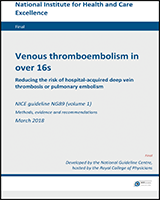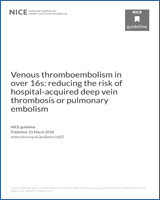NCBI Bookshelf. A service of the National Library of Medicine, National Institutes of Health.
National Guideline Centre (UK). Venous thromboembolism in over 16s: Reducing the risk of hospital-acquired deep vein thrombosis or pulmonary embolism. London: National Institute for Health and Care Excellence (NICE); 2018 Mar. (NICE Guideline, No. 89.)
December 2019: In recommendation 1.3.5 the British Standards for anti-embolism hosiery were updated because BS 6612 and BS 7672 have been withdrawn. August 2019: Recommendation 1.12.11 (1.5.30 in this document) was amended to clarify when anti-embolism stockings can be used for VTE prophylaxis for people with spinal injury.

Venous thromboembolism in over 16s: Reducing the risk of hospital-acquired deep vein thrombosis or pulmonary embolism.
Show details14.1. Introduction
Patients diagnosed with acute coronary syndromes (ACS) are treated with anti-thrombotics. These treatments primarily consist of aspirin, clopdidogrel or other thienopyridines and heparin. The duration of each therapy varies, with aspirin often being life-long, clopidogrel in the order of 12 months and heparin for a period of three to five days post-event. Dual antiplatelet agents are also often given for a period which may be for up to a year after drug eluting coronary stent insertion. If full dose anticoagulation is stopped the protection it provides diminishes, allowing an increased risk of VTE. The VTE effectiveness of dual antiplatelet regimes remains largely unstudied in this context but will increase bleeding risk.
14.2. Review question: What is the effectiveness of different pharmacological and mechanical prophylaxis strategies (alone or in combination) for people being treated for acute coronary syndromes (using anticoagulants and/or antiplatelet agents)?
For full details see review protocol in appendix C.
Table 72
PICO characteristics of review question.
14.3. Clinical evidence
No relevant clinical studies comparing the effectiveness of different pharmacological and mechanical prophylaxis strategies (alone or in combination) for people with acute coronary syndromes. See the study selection flow chart in appendix E and excluded studies list in appendix N. Seven studies that were included in CG92 were excluded from the review. Reasons for exclusion include incorrect population, incorrect intervention, incorrect study design and no relevant outcomes20, 70, 92, 153, 15 55 195.
14.4. Economic evidence
Published literature
No relevant health economic studies were identified.
See also the health economic study selection flow chart in appendix F.
14.5. Evidence statements
Clinical
No relevant clinical studies were identified.
Economic
No relevant economic evaluations were identified.
14.6. Recommendations and link to evidence
| Recommendations |
|
| Research recommendation | None |
| Relative values of different outcomes |
The committee considered all-cause mortality (up to 90 days from hospital discharge), deep vein thrombosis (symptomatic and asymptomatic) (7–90 days from hospital discharge), pulmonary embolism (7–90 days from hospital discharge), major bleeding (up to 45 days from hospital discharge) and fatal PE (7–90 days from hospital discharge) as critical outcomes. The committee considered health-related quality of life (up to 90 days from hospital discharge), clinically relevant non-major bleeding (up to 45 days from hospital discharge), heparin-induced thrombocytopenia (duration of study) and technical complications of mechanical interventions (duration of study) as important outcomes. Please see section 4.4.3 in the methods chapter for further detail on prioritisation of the critical outcomes. |
| Quality of the clinical evidence | No relevant clinical evidence identified. The committee noted that the studies that were previously included in the review were published in the 1970s/80s and that treatment for acute coronary syndromes has since changed. Based on this the committee agreed that these studies are no longer applicable and decided to exclude them. |
| Trade-off between clinical benefits and harms |
No relevant clinical evidence was identified. The committee noted that people treated for acute coronary syndromes will be on anticoagulant agents to manage their condition. These agents would also act as prophylaxis against VTE. Consequently, the committee considered there is no need to offer additional pharmacological prophylaxis when these agents are being used (even though the level of anticoagulation with rivaroxaban/fondaparinux is not therapeutic). The committee also noted that some of these patients may be on dual or triple antiplatelet therapy and adding prophylaxis could increase the risk of bleeding. For this population of people with acute coronary syndromes, the committee decided to cross-refer to the recommendations for people using anticoagulation and people using antiplatelet agents. The committee also noted that there was no evidence examining the effectiveness of mechanical prophylaxis. Without any evidence the committee decided not to offer additional mechanical prophylaxis to patients taking vitamin K agonists or receiving full anticoagulation therapy. |
| Trade-off between net clinical effects and costs | No relevant economic studies were identified. Unit costs of pharmacological and mechanical prophylaxis were presented to the committee (see appendix Q). The committee acknowledged that this population will be receiving therapeutic doses of anticoagulation and additional prophylaxis is unlikely to offer a clinical benefit. The committee considered the possible side effects and the additional cost of prescribing prophylaxis to this population and considered that offering additional prophylaxis to this population is unlikely to be cost effective. |
| Other considerations | The committee note that further guidance on the peri-operative management of patients on anticoagulation and antiplatelet therapy, including advice on when to restart their treatment, is provide in the British Society for Haematology guidance on Peri-operative management of anticoagulation and antiplatelet therapy published in 2016 (available from http: |
- Introduction
- Review question: What is the effectiveness of different pharmacological and mechanical prophylaxis strategies (alone or in combination) for people being treated for acute coronary syndromes (using anticoagulants and/or antiplatelet agents)?
- Clinical evidence
- Economic evidence
- Evidence statements
- Recommendations and link to evidence
- People with acute coronary syndromes - Venous thromboembolism in over 16sPeople with acute coronary syndromes - Venous thromboembolism in over 16s
Your browsing activity is empty.
Activity recording is turned off.
See more...
